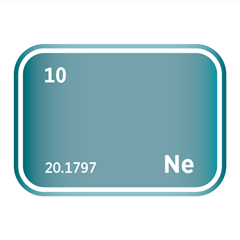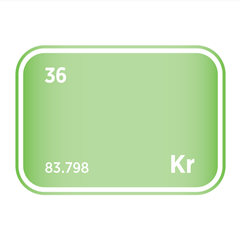Xenon
Critical Minerals and The Energy Transition
Navigating the Xenon Market
Xenon, a rare and valuable noble gas, plays a crucial role across a wide range of high-tech and industrial applications. Primarily used in lighting, xenon is critical in high-intensity discharge lamps and vehicle headlights, providing bright and efficient illumination. Its significance extends to the medical field, where it is utilised as an anaesthetic and in imaging technologies such as MRI and CT scans, enhancing diagnostic capabilities and patient care. Additionally, xenon is vital in space exploration as a propellant for ion thrusters, enabling efficient and long-duration missions. The demand for xenon is driven by its unique properties, yet it is also shaped by its limited availability and the high cost of extraction and production. The xenon market faces challenges, including supply constraints, price volatility, and the need for sustainable production methods. As technological advancements continue to expand the applications of xenon, the industry is at the forefront of innovation, striving to balance the demands of cutting-edge technology and sustainable resource management.
An introduction to xenon
Xenon demand and end-uses
Xenon is a rare, inert noble gas with a unique combination of chemical stability, high atomic weight, and specialised physical properties that make it essential across a range of advanced technologies. Though produced and consumed in small volumes compared to other industrial gases, xenon plays a disproportionately important role in high-performance sectors, including space propulsion, medical imaging, lighting, electronics, and national security. Its scarcity, combined with its critical applications, makes xenon one of the most valuable industrial gases in the world.
One of the most strategically important uses of xenon is in space propulsion, particularly in electric ion thrusters used for satellite station-keeping, orbital manoeuvres, and deep-space missions. Xenon is the propellant of choice for ion engines due to its high atomic mass, inertness, and ease of ionisation, which enable precise, fuel-efficient propulsion in the vacuum of space. As the number of satellites and commercial space missions continues to grow, xenon demand from the aerospace sector is expected to rise significantly, especially in geostationary communications, Earth observation, and interplanetary exploration programmes.
In medical imaging, xenon plays a key role in anaesthesia and diagnostic scanning. Xenon-133, a radioactive isotope, is used in nuclear medicine for pulmonary ventilation studies and cerebral blood flow imaging, helping diagnose lung function and neurological conditions. In its stable form, xenon also acts as a rare but highly effective inhalation anaesthetic, valued for its rapid onset, minimal side effects, and neuroprotective qualities. Its high-cost limits widespread use, but it remains relevant in specialised surgical procedures and clinical research.
Xenon is widely used in high-intensity lighting, where it produces bright, white light with excellent colour rendering. Xenon arc lamps are found in cinema projectors, searchlights, solar simulators, laboratory equipment, and premium automotive headlamps. These lamps create an electric arc in xenon gas, producing a daylight-like spectrum ideal for high-precision or outdoor lighting. Although some markets have shifted towards LEDs and solid-state lighting, xenon remains the preferred option where intensity and UV output are essential.
In semiconductor manufacturing, xenon is used in plasma etching and ion implantation, supporting the fabrication of advanced microchips and integrated circuits. Its chemical inertness and atomic properties allow for fine control during the etching of nanoscale features and the modification of electrical properties in silicon wafers. As semiconductor geometries shrink and complexity increases, xenon plays an increasingly important role in next-generation electronics, including logic chips, memory, and sensors.
Xenon is also used in scientific research, including nuclear physics, quantum computing, and particle detection. Due to its density, high scintillation yield, and purity, liquid xenon is an ideal detection medium in dark matter and neutrino experiments. These applications are small in volume but critical to scientific discovery and technological leadership.
Looking ahead, xenon demand is expected to grow, driven by the expansion of space-based infrastructure, semiconductor manufacturing, and advanced medical imaging. While its use in some traditional lighting applications may decline, emerging demand in space propulsion, chip production, and scientific instrumentation will likely outweigh those losses. However, the challenge remains that xenon supply cannot easily be scaled without broader increases in industrial gas production, leading to potential tightness in the market.
With its unmatched combination of inertness, ionisation efficiency, and optical clarity, xenon is poised to remain a critical enabler of high-precision and frontier technologies. From deep space to the nanofabrication cleanroom, and from the operating theatre to the research lab, xenon plays a quiet but irreplaceable role in shaping the future of science, defence, and clean technology.

Strategic applications of Xenon
Xenon supply
Xenon supply is inherently constrained by its rarity in the atmosphere and the complexity of its recovery. It constitutes only about 0.087 parts per million of Earth’s atmosphere, making it the least abundant of the stable noble gases. Because xenon is not mined directly, it is obtained as a by-product during the cryogenic distillation of air, an energy-intensive process primarily designed to recover oxygen, nitrogen, and argon. Xenon is separated in the final stages of air separation, often alongside krypton, using additional low-temperature rectification steps or adsorption technologies.
Global xenon production is therefore tightly linked to the operation of high-capacity air separation units (ASUs), typically located near large steelworks, ammonia plants, semiconductor fabrication facilities, and other energy-intensive industries. This geographically concentrates xenon supply in regions with primary industrial gas operations, such as the United States, Germany, Japan, Russia, China, and Ukraine. Facilities operated by companies like Air Liquide, Linde, and Air Products are key global suppliers, though overall output remains modest and sensitive to fluctuations in industrial oxygen demand.
Russia has historically been one of the largest xenon exporters due to its extensive air separation infrastructure linked to its metallurgical sector. Still, geopolitical disruptions have introduced volatility into the market. Ukraine, too, played a notable role in xenon exports before the war, and its facilities have faced production interruptions due to the conflict. This has placed additional pressure on Western supply chains, particularly for high-purity xenon used in medical imaging, semiconductor lithography, and space propulsion.
Due to xenon’s niche but high-value applications, demand is relatively inelastic in ion thrusters, excimer lasers, anaesthetics, and semiconductor manufacturing. However, the market's small size means it is vulnerable to sharp price swings and occasional shortages, especially when oxygen production slows or industrial gas facilities face maintenance downtime.
Due to its critical applications in aerospace, medical technologies, and microelectronics, xenon is increasingly considered a strategic element. However, few countries formally stockpile xenon, and commercial reserves are typically limited. The element’s extremely low atmospheric concentration and dependency on oxygen production mean that even small shifts in industrial activity or supply disruptions, such as geopolitical tensions or maintenance outages at major ASUs, can lead to significant price volatility. Spot prices have historically seen sharp spikes, particularly during disruptions in Eastern Europe, where xenon export volumes are material to global supply.
Secondary supply via recycling is possible, particularly from excimer laser systems and space thrusters, but the infrastructure for large-scale xenon recovery is limited. As demand for xenon in advanced technologies grows, improving recycling processes and expanding ASU capacity will be key to maintaining a stable and resilient global supply.
Demand for xenon is expected to grow due to its expanding role in semiconductor lithography, deep-space propulsion systems, and high-end medical imaging. The transition to more sophisticated integrated circuits and EUV lithography is especially xenon-intensive, pushing chip manufacturers to secure stable, long-term supply agreements. Additionally, as private and government-led space missions scale up, xenon’s use in ion propulsion systems is poised to become a more prominent demand driver. These trends may encourage new investments in air separation infrastructure and developing dedicated xenon capture enhancements in existing ASUs.
Xenon substitution
Substitution for xenon is minimal due to its unique physical and chemical properties, particularly its inertness, high atomic weight, and ability to emit bright, stable light. In many of its critical applications, such as ion propulsion, anaesthesia, and excimer laser lithography, xenon performs functions that are not easily replicated by other elements or compounds without sacrificing performance, safety, or efficiency.
In spacecraft propulsion, xenon is used in ion thrusters because of its high atomic mass and low ionisation energy, making it highly efficient for generating thrust. Alternatives such as krypton and argon have been used, particularly in lower-cost or experimental systems. Still, these gases are generally less efficient and require more energy to produce equivalent thrust. Krypton, while more abundant and cheaper, provides lower performance and has not yet been widely adopted for deep-space missions where high specific impulse is critical.
In medical anaesthesia, xenon offers neuroprotective and cardiovascular stability benefits unmatched by most alternatives. While other gases, such as nitrous oxide or sevoflurane, are more widely used and less expensive, they do not provide the same physiological stability or environmental benignity. As a result, xenon remains preferred for high-risk patients, though cost severely limits its broader adoption.
In semiconductors, xenon is essential in excimer lasers for deep ultraviolet lithography (DUV and EUV). Alternatives like krypton fluoride (KrF) or argon fluoride (ArF) can be used for earlier-generation lithography tools. Still, they do not match the precision or resolution required for next-generation chip manufacturing. Substituting xenon in this context would mean reverting to less advanced manufacturing techniques or requiring major process redesigns.
In lighting and imaging applications, such as high-intensity discharge lamps, plasma display panels, and medical imaging contrast agents, xenon is sometimes substituted with krypton, argon, or halogen-based systems. However, these substitutions often reduce light quality, energy efficiency, or imaging resolution.
Overall, xenon’s role in high-precision, high-performance technologies means substitution is technically feasible in only a narrow set of applications and often involves trade-offs in performance, efficiency, or safety. As demand increases in space, electronics, and medical sectors, substitution alone is unlikely to significantly reduce xenon dependence without breakthroughs in materials science, propulsion, and lithography technologies.



Meet the Critical Minerals team
Trusted advice from a dedicated team of experts.

Henk de Hoop
Chief Executive Officer

Beresford Clarke
Managing Director: Technical & Research

Jamie Underwood
Principal Consultant

Ismet Soyocak
ESG & Critical Minerals Lead

Rj Coetzee
Senior Market Analyst: Battery Materials and Technologies

How can we help you?
SFA (Oxford) provides bespoke, independent intelligence on the strategic metal markets, specifically tailored to your needs. To find out more about what we can offer you, please contact us.



























